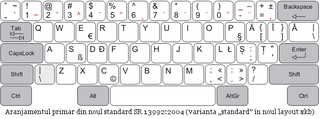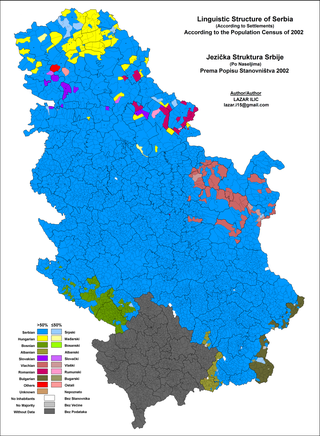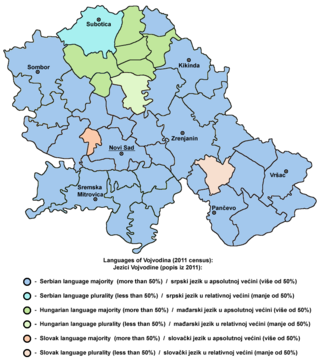
Demographic features of the population of Hungary include population density, ethnicity, education level, health of the populace, economic status, religious affiliations and other aspects.
A minority language is a language spoken by a minority of the population of a territory. Such people are termed linguistic minorities or language minorities. With a total number of 196 sovereign states recognized internationally and an estimated number of roughly 5,000 to 7,000 languages spoken worldwide, the vast majority of languages are minority languages in every country in which they are spoken. Some minority languages are simultaneously also official languages, such as Irish in Ireland or the numerous indigenous languages of Bolivia. Likewise, some national languages are often considered minority languages, insofar as they are the national language of a stateless nation.

Vas is an administrative county of Hungary. It was also one of the counties of the former Kingdom of Hungary. It is part of the Centrope Project.

Prekmurje is a geographically, linguistically, culturally and ethnically defined region of Slovenia, settled by Slovenes and a Hungarian minority, lying between the Mur River in Slovenia and the Rába Valley in the westernmost part of Hungary. It maintains certain specific linguistic, cultural and religious features that differentiate it from other Slovenian traditional regions. It covers an area of 938 square kilometers (362 sq mi) and has a population of 78,000 people.
Boyash or Bayash refers to a Romani ethnic group living in Romania, southern Hungary, northeastern and northwestern Croatia, western Vojvodina, Slovakia, the Balkans, but also in the Americas. Alternative names are Rudari (Ludari), Lingurari and Zlătari.

The United States of Greater Austria was an unrealized proposal made in 1906 to federalize Austria-Hungary to help resolve widespread ethnic and nationalist tensions. It was conceived by a group of scholars surrounding Archduke Franz Ferdinand of Austria, notably by the ethnic Romanian lawyer and politician Aurel Popovici.

Beyond the official Romanian language, multiple other languages are spoken in Romania. Laws regarding the rights of minority languages are in place, and some of them have co-official status at a local level. Although having no native speakers, French language is also a historically important language in Romania, and the country is a member of the Organisation internationale de la Francophonie.
About 9.3% of Romania's population is represented by minorities, and 13% unknown or undisclosed according to 2021 census. The principal minorities in Romania are Hungarians and Romani people, with a declining German population and smaller numbers of Poles in Bukovina, Serbs, Croats, Slovaks and Banat Bulgarians, Ukrainians, Greeks, Jews, Turks and Tatars, Armenians, Russians, Afro-Romanians, and others.
Languages of Yugoslavia are all languages spoken in former Yugoslavia. They are mainly Indo-European languages and dialects, namely dominant South Slavic varieties as well as Albanian, Aromanian, Czech, German, Italian, Venetian, Balkan Romani, Romanian, Pannonian Rusyn, Slovak and Ukrainian languages. There are also pockets where varieties of non-Indo-European languages, such as those of Hungarian and Turkish, are spoken.

Serbia has only one nationwide official language, which is Serbian. The largest other languages spoken in Serbia include Hungarian, Bosnian and Croatian. The Autonomous Province of Vojvodina has 6 official languages: Serbian, Hungarian, Slovak, Romanian, Croatian, Rusyn; whilst Autonomous Province of Kosovo and Metohija, which Serbia claims as its own, has two: Albanian and Serbian.

The languages of Austria include German, the official language and lingua franca; Austro-Bavarian, the main dialect outside Vorarlberg; Alemannic, the main dialect in Vorarlberg; and several minority languages.

Slovenia has been a meeting area of the Slavic, Germanic, Romance, and Uralic linguistic and cultural regions, which makes it one of the most complex meeting point of languages in Europe. The official and national language of Slovenia is Slovene, which is spoken by a large majority of the population. It is also known, in English, as Slovenian. Two minority languages, namely Hungarian and Italian, are recognised as co-official languages and accordingly protected in their residential municipalities. Other significant languages are Croatian and its variants and Serbian, spoken by most immigrants from other countries of former Yugoslavia and their descendants. Slovenia is ranked among the top European countries regarding the knowledge of foreign languages. The most often taught foreign languages are English and German, followed by Italian, French, and Spanish.

Languages and dialects spoken in the Serbian province of Vojvodina include South Slavic languages, West Slavic languages (Slovak), East Slavic languages (Rusyn), Hungarian, Romanian, Romani, and others.

The population of Budapest was 1,735,041 on 1 January 2013. According to the 2011 census, the Budapest metropolitan area was home to 2,530,167 people and the Budapest commuter area had 3.3 million inhabitants. The Hungarian capital is the largest in the Pannonian Basin and the ninth largest in the European Union. Budapest is also the primate city of Hungary and some neighbouring territories.

The Constitution of Croatia in its preamble defines Croatia as a nation state of ethnic Croats, a country of traditionally present communities that the constitution recognizes as national minorities and a country of all its citizens. National minorities explicitly enumerated and recognized in the Constitution are Serbs, Czechs, Slovaks, Italians, Hungarians, Jews, Germans, Austrians, Ukrainians, Rusyns, Bosniaks, Slovenes, Montenegrins, Macedonians, Russians, Bulgarians, Poles, Romani, Romanians, Istro-Romanians ("Vlachs"), Turks and Albanians. Article 12 of the constitution states that the official language in Croatia is Croatian, but also states that in some local governments another language and Cyrillic or some other script can be introduced in official use.

Minority languages are spoken in a number of autochthonous settlements in Austria. These are:

Szentendre is a district in north-western part of Pest County. Szentendre is also the name of the town where the district seat is found. The district is located in the Central Hungary Statistical Region.

Szigetszentmiklós is a district in south-western part of Pest County. Szigetszentmiklós is also the name of the town where the district seat is found. The district is located in the Central Hungary Statistical Region.
The ethnic groups in Yugoslavia were grouped into constitutive peoples and minorities.
The various regional and minority languages in Europe encompass four categories:
















